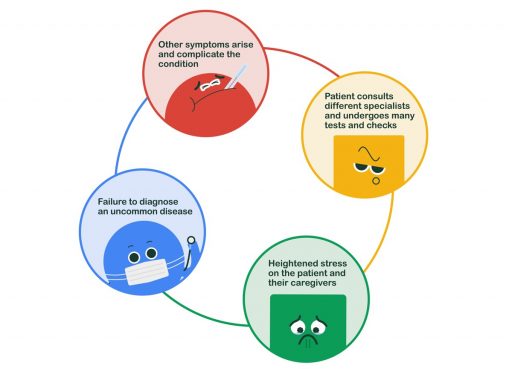What is an undiagnosed disease?
An undiagnosed disease is any medical condition without an exact diagnosis or known cause after thorough evaluation, clinical assessments and routine investigations. These undiagnosed diseases often display symptoms that can be associated with many different diseases, for example, developmental disabilities and epilepsy. The ambiguity and complexity of such presenting symptoms, among many others, is exceptionally challenging for medical professionals to find the true cause and identify the disease.
Examples of undiagnosed diseases:
- Any disease without a known cause and name – it can only be classified as an “undiagnosed disease” until a clinician successfully finds the cause of the disease and its associated name
- Atypical presentations of known diseases – it is difficult to diagnose the disease when the individual experiences symptoms that are unusual for that disease
- Newly found diseases and diseases that have not been described before
How does an undiagnosed disease affect patients and their families?
When the cause of the disease remains unknown, the patients often need to keep consulting different medical specialists to look for the cause and undergoing, repeated clinical test or imaging that could be invasive or expensive. This increases the physical, psychological and financial turmoil on the patients and their caregivers, and compromises their quality of life.
Adding to the strain are the many unfruitful regimes and procedures that a patient may have to go through because of uncertainties in diagnosis, which could aggravate their condition and send them into a vicious cycle:

Significance of Whole Genome Sequencing
Case Study (1) – Enhance Diagnostic Rate
Patient A was a 4-year-old boy with developmental delay and epilepsy. He needed regular clinic visits and medication to manage the condition. After various medical tests, the cause of his disease remained unknown.
With Whole Genome Sequencing, the medical professionals successfully identified the variants in his genome that were related to his condition and were thus able to provide more targeted and effective treatment.
His parents always wanted a second child but were worried that the child might suffer from the same disease. The Whole Genome Sequencing results of both parents revealed that there was no hereditary link regarding the boy’s genetic variant. This discovery eased their worries and greatly helped with their family planning.
Case Study (2) – Identify the Cause of Disease for Future Planning
Patient B had experienced problems with multiple organs. In addition to regular visits to the paediatrician since the age of two, he also needed to frequently consult neurologists, cardiologists, ophthalmologists, and orthopaedics.
Over the years, medical professionals suspected that the issues were caused by genetic variants. But after many clinical and routine tests for known genetic diseases, the quest for a clear diagnosis seemed in vain.
When Patient B reached the age of 20, medical professionals successfully identified the disease-causing genetic variants through Whole Genome Sequencing. Although the diagnosis did not promise that Patient B would recover completely, this new knowledge helped him make better informed decisions for his future.
Initially, when the cause of the disease was still unknown, one of Patient B’s clinicians predicted that his heart function would gradually deteriorate. However, the results of Whole Genome Sequencing revealed that the genetic disease he lived with would have little impact on his heart function. With this knowledge and advice from his cardiologist, Patient B was able to resume low to medium intensity exercises and thus regain the joy of an active lifestyle.
